NASA APOD #922-928
#922 Keck: The Largest Optical Telescopes December 27, 1997
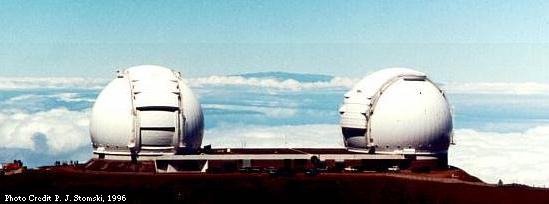
“In buildings eight stories tall rest mirrors ten meters across that are slowly allowing humanity to map the universe. Alone, each is the world's largest optical telescope: Keck. Together, the twin Keck telescopes have the resolving power of a single telescope 90-meter in diameter, able to discern sources just milliarcseconds apart. Since opening in 1992, the real power of Keck I (left) has been in its enormous light-gathering ability - allowing astronomers to study faint and distant objects in our Galaxy and the universe. Keck II, completed last year, and its twin are located on the dormant volcano Mauna Kea, Hawaii, USA. In the distance is Maui's volcano Haleakala. One reason Keck was built was because of the difficulty for astronomers to get funding for a smaller telescope."
Copyright: Public domain
#923 Pluto: The Frozen Planet December 28, 1997
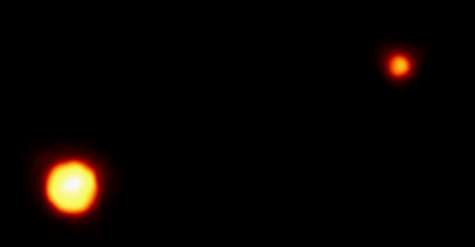
“The Hubble Space Telescope imaged Pluto and its moon Charon in 1994. Pluto is usually the most distant planet from the Sun but because of its elliptic orbit Pluto crossed inside of Neptune's orbit in 1979 and will cross back out again in 1999. Compared to the other planets, very little is known about Pluto. Pluto is smaller than any other planet and even smaller than several other planet's moons. From Pluto, the Sun is just a tiny point of light. Pluto is probably composed of frozen rock and ice, much like Neptune's moon Triton. Pluto has not yet been visited by a spacecraft, but a mission is being planned for the next decade."
Copyright: Public domain
#924 The Milky Way in Infrared December 29, 1997
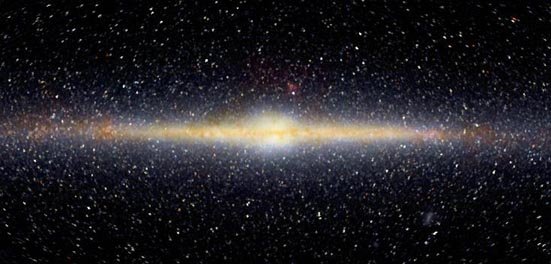
“At night, from a dark location, part of the clear sky looks milky. This unusual swath of dim light is generally visible during any month and from any location. Until the invention of the telescope, nobody really knew what the "Milky Way" was. About 300 years ago telescopes caused a startling revelation: the Milky Way was made of stars. Only 70 years ago, more powerful telescopes brought the further revelation that the Milky Way is only one galaxy among many. Now telescopes in space allow yet deeper understanding. The above picture was taken by the COBE satellite and shows the plane of our Galaxy in infrared light. The thin disk of our home spiral galaxy is clearly apparent, with stars appearing white and interstellar dust appearing red."
Copyright: Public domain
#925 NGC 7009: The Saturn Nebula December 30, 1997
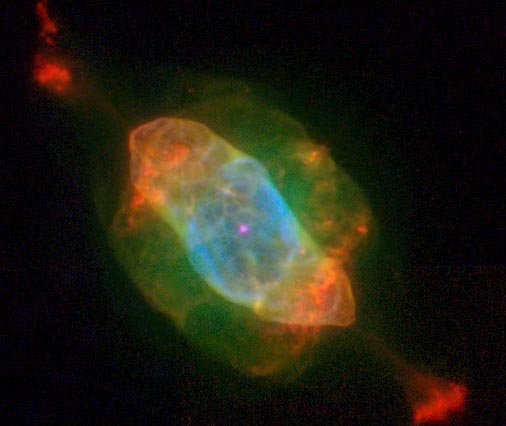
“The layers of the Saturn Nebula give a complex picture of how this planetary nebula was created. The above picture, taken in April 1996 and released last week, allows a better understanding of the mysterious process that transformed a low-mass star into a white dwarf star. A computer model indicates that the central star of NGC 7009 first expelled the green gas that now appears barrel shaped. This green gas now confines stellar winds flowing from the central star, creating a jet which forms the ansae that appear in red at the tips. Much remains unknown, including why the gas has not become turbulent."
Copyright: Public domain
#926 NGC 5307: A Symmetric Planetary Nebula December 31, 1997

“Some stellar nebulae are strangely symmetric. For example, every major blob of gas visible on the upper left of NGC 5307 appears to have a counterpart on the lower right. This picture taken by the Hubble Space Telescope was released last week. NGC 5307 is an example of a planetary nebula with a spiral shape. Spiral planetary nebulae are thought to be caused by a bright central white dwarf star expelling a symmetric wobbling jet of rapidly moving gas. It takes light about 10,000 years to reach us from NGC 5307, and about 6 months just to go from one side to the other. In contrast, light takes only about 8 minutes to reach Earth from the Sun."
Copyright: Public domain
#927 The Largest Rock Known January 01, 1998
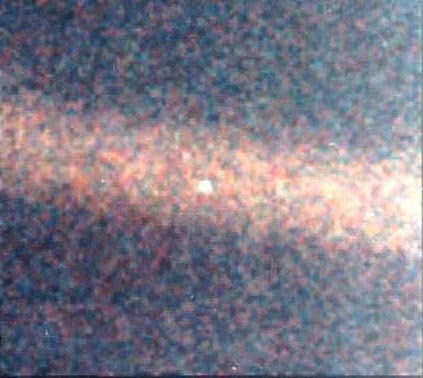
“There, that faint dot in the center - that's the largest rock known. It is larger than every known asteroid, moon, and comet nucleus. It is larger than any other rocky planet. (Nobody knows for sure what size rocks lie at the cores of Jovian planets, or orbit other stars.) The Voyager 1 spacecraft took this picture in 1990 from the outer Solar System. This rock is so large its gravity makes it nearly spherical, and holds heavy gases near its surface. Today, this rock starts another orbit around its parent star, for roughly the 5 billionth time, spinning over 350 times during each trip. Happy Gregorian Calendar New Year to all the human inhabitants of this rock we call Earth."
Copyright: Public domain
#928 Europa's Disconnected Surface January 02, 1998
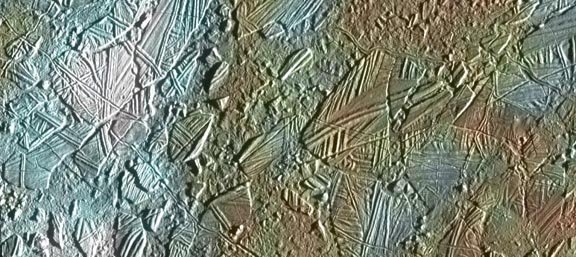
“Jupiter's moon Europa is so exciting that the Galileo spacecraft orbiting Jupiter has now embarked on an extended mission to study it. Oceans that might exist beneath Europa's surface are thought to be one of the best places to look for life in our Solar System. The Galileo Europa Mission has planned eight close fly-bys frozen moon. The first close encounter of this extended mission occurred last December and the next will occur in February. The above enhanced color picture shows a small region of Europa's Conamara region. The white and blue colors highlight regions covered by ice dust from the collision that created the Pwyll Crater. Disconnected islands of ice are visible that have apparently rafted to new positions."
Copyright: Public domain
Upvote! Resteem! Comment! As you like it! Thank you for attention!